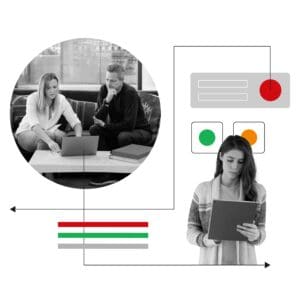What is a Bill of Materials?
A Bill of Materials or BOM is not just an inventory list; it’s a critical tool for any manufacturer looking to scale their small manufacturing business.
It details all the materials, components (and in a multi-level BOM all the sub-components), quantities, and often the assembly instructions necessary to create a product. Effectively managing a BOM means having accurate data for forecasting, reducing waste, and ensuring efficient use of resources.
In the world of scaling businesses, a well-organised BOM is instrumental in transitioning from ‘making do’ to ‘strategically growing.’
At the most basic level, bills of materials can be either simple or multi-level in their nature.
That is, specifying a straightforward ‘recipe’ for the production of an item from complete components
Or, in the case of a multilevel BOM, specifying the more complex production of a product, perhaps with a mix of sub-assemblies and raw components. The below examples are a simplified illustration of this principle.
For manufacturers in the device, machinery and equipment sector, multi-level BOMs are common and as a high degree of customisation is common in this sector, the software you use to create, manage and report on your bills of materials should be able to cope with these highly complex assemblies.


Different types of BOM
There are two primary types of BOMs – Engineering BOMs (EBOM) and Manufacturing BOMs (MBOM).
EBOMs originate from design documents such as CAD Drawings and focus on the design aspects of a product.
MBOMs, meanwhile, take this information and adapt it for actual production needs. MBOMs are often multi-level BOMs, meaning they not only detail all of the components and processes involved in putting together a device but will also detail the components involved in the creation of any sub-assemblies involved in the product’s manufacture – giving you a detailed understanding of all of your resource requirements.
Some organisations will also refer to a “SALES BOM.” This relates to products or groups of products that are put together at the point of sale or despatch. This might be for example if your business manufactures and sells ‘sets’ of products together whether as part of a sales promotion or because they naturally form a complete set.
A Sales BOM will typically be made up of completed products so does not require sub-assemblies or component parts. If your business ‘makes to stock’ (as opposed to make to order) you may use Sales BOMs to manage more complicated orders and ensure accurate warehouse picking.
For a business scaling up, understanding these different types of BOM and utilising them effectively is key to ensuring that the production process is not only efficient but also aligned with the company’s growth strategy.

Unlocking growth with BOM software
Small manufacturers often grapple with scaling their operations, particularly in areas like stock control, production planning, and cash flow forecasting.
BOMs are essential in addressing these challenges, offering a structured approach to managing resources and predicting needs. They become the foundation for making informed decisions about material or component requirements, helping businesses transition from reactive to proactive management.
- Accuracy and Efficiency: BOM software significantly reduces the risk of errors associated with manual data entry. It allows for precise tracking and management of components, ensuring that the right parts are used at the right time. This leads to more efficient production processes and better quality control.
- Cost Management: By providing detailed insight into the components required for production, BOM software helps in better budgeting and cost control. It can track the cost of each component and help identify areas where expenses can be reduced, leading to more cost-effective production.
- Time-saving and Collaboration: BOM software streamlines collaboration among different departments by providing a centralised and accessible platform for all BOM-related information. This improves communication and reduces the time spent on coordinating and updating BOMs, leading to faster project completion and increased productivity.
Accurate multi-level BOMs allow small manufacturers to forecast inventory requirements based on real-world data. When an order is confirmed, the software will use the bill of materials to assign the correct components or sub-assemblies to that order. This allows the purchasing team to accurately predict when they need to replenish their stock, avoiding stockouts and therefore costly production delays.
As a small business, cashflow and storage space are often at a premium so ensuring you’re not tying up money or wasting space on unnecessary inventory is an added strength for your business.
The production schedule can also rely on timings stored in the BOM to help schedule manufacturing and assembly tasks at the appropriate time.
Implementing and Supporting BOM Software.
The transition to a digital BOM system (typically as part of an MRP system) can be a significant leap for small manufacturers.
Choosing the right MRP software is just the first step in a long journey towards fully integrating your business. Be sure to choose a package that offers the core functionality you need for your business in this current moment but which has the ability to add higher-level functions or integrate with more sophisticated software as your business grows.
Also, consider if one package can satisfy all your current needs – as well as being more cost-efficient, the fewer platforms you have to integrate the better, as there are fewer potential ‘points of failure’ in your process.
For example, often small manufacturers operate in well-defined niches meaning they have a relatively straightforward sales process. This means that often a highly sophisticated (and therefore expensive) CRM system isn’t absolutely necessary to achieve their goals. Added to that, high-level CRMs are often complex to learn and often become redundant when the sales team realise the work required to maintain the data needed to make them operate efficiently.
Flowlens offers a simple CRM as part of our platform which we’ve found to have all the functionality most small manufacturers need to effectively manage their sales pipeline, assign tasks, schedule follow-ups and report on their progress.
Flowlens is designed for start-up and scale-up businesses, so it allows users to start small with a core package starting at just £349 per month. More premium add-ons such as real-time data feeds and aftersales service modules are available when your business needs to continue its growth trajectory.
Ready to Start Your Digital Journey?
We’ve analysed hundreds of successful MRP implementations, and in this FREE e-book, we break down the essential steps you need to follow to ensure your digital transformation is a success.


Flowlens – Catering to the Unique Needs of Small Manufacturers
Effective implementation and ongoing support are vital to harness the full potential of BOM software. This includes training staff, integrating the BOM system with existing operations, and migrating data across from legacy systems or even from hard copy processes!
Implementation can be a particular challenge for small manufacturers who often don’t have team members with the free time to become a full-time ‘digital champion’ or project manager for an MRP Implementation.
Flowlens stands out as an example of MRP software that is firstly intuitively designed and therefore faster to learn but importantly doesn’t abandon new subscribers to a ‘self-serve’ learning portal or series of ‘how to videos.’
We offer hands-on in-person integration services with our own team to ensure your implementation is a success. This is a complex and often daunting journey but our in-house team have guided hundreds of businesses like yours through this process and can ensure your system is set up correctly, your data properly migrated and your people are fully trained before you ‘go live.’
Additionally, we’re based right here in the UK and deal with all support queries and development requests right here with our in house team. We’re just a phone call or email away and our customers have rated us as best in class for our customer support year after year!
Conclusion
For small manufacturers ready to scale up, understanding and implementing a robust BOM system as part of an MRP software package is more than a necessity; it’s a strategic move towards a more efficient, insight-driven future.
Platforms like Flowlens not only simplify this transition but also empower businesses with the tools to manage their growth effectively. Embracing BOM software is the first step in transforming your small manufacturing business into a more streamlined, insightful, and competitive enterprise.
Ready to see the potential of your manufacturing business?





